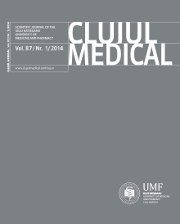Pill –Induced Erosive Esophagitis in Children
DOI:
https://doi.org/10.15386/cjm.2014.8872.871.mab1Keywords:
children, drug-induced esophagitis, endoscopic features, managementAbstract
Aims. Pill-induced esophagitis has been recognized in adults, but rarely in children. The aim of this article is to discuss endoscopic features, drugs implicated, prevention and treatment in pill-induced esophagitis in children.
Patients and methods. Over a period of 4 years, 26 patients presented at our clinic with drug-induced esophageal ulcerations. All patients were diagnosed by means of endoscopy and treated with proton-pump inhibitors and prokinetics. The mean age of the children was 10.76 years.
Results. The ulcers were frequently located at the mid-esophagus. Odynophagea, retrosternal pain and dysphagia were the most common presenting symptoms. All children took pills (non- steroidal anti-inflammatory drugs, antibiotics – Doxycycline and ferrous sulfate) with little water and at bed time. The mean elapse between the drug intake and endoscopy was 4.96 days. The symptoms resolved within a maximum of one week of antireflux therapy.
Conclusions. In pediatric cases treated by tablets or capsules, the possibility of medication-induced esophagitis should always be considered. The drug-induced esophagitis should be suspected in all patients presenting with chest pain and dysphagia. Physicians must warn the patients to take the pills and capsules with enough water and in the upright position.
Downloads
Published
How to Cite
Issue
Section
License
The authors are required to transfer the copyright of the published paper to the journal. This is done by agreeing to sign the Copyright Assignment Form. Whenever the case, authors are also required to send permissions to reproduce material (such as illustrations) from the copyright holder.

The papers published in the journal are licensed under a Creative Commons Attribution-NonCommercial-NoDerivatives 4.0 International License.

